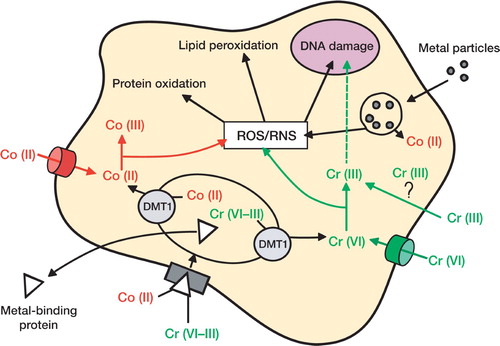Figures & data
Table 1. Survivorship for the currently used hip resurfacing systems
Table 2. Studies on cobalt and chromium ion levels
Table 3. Currently available hip resurfacing systems
Table 4. Reports of periprosthetic soft-tissue mass in MoM bearings
Different pathways used by metal ions to enter into the cells. Cr(VI) can cross the cytoplasmic membrane through the non-specific phosphate/sulphate anionic transporters. Within the cell, Cr(VI) undergoes rapid metabolic reduction to form Cr(V), Cr(IV), and finally Cr(III). At each step of Cr(VI) reduction, reactive oxygen species (ROS) and reactive nitrogen species (RNS) are generated. Whether or not Cr(III) is able to cross the cell membrane on its own without a carrier remains controversial. Co(II) can cross the cell membrane using the non-specific iron transporter and it is oxidized in the cytosol to Co(III). Co-oxidation leads to the generation of ROS and RNS. Co(II) and Cr(VI–III) can also bind some metal-binding proteins such as transferrin or ferritin. In the endosome, Co(II) and Cr(VI–III) are unbound from their protein carrier; via the DMT1 transporter, they are released in the cytosol where they can be reduced/ oxidized and result in the generation of ROS/RNS. ROS and RNS are known to be involved in protein oxidation, leading to their degradation, lipid peroxidation, and DNA damage. Cr(III) can also cross the nuclear membrane and participate in alteration of DNA. Metal particles, released from the articulating surface of the MoM prosthesis, can be phagocytosed by the cells. Inside the phago-lysosome, particles become corroded and release metal ions in the cytosol.
